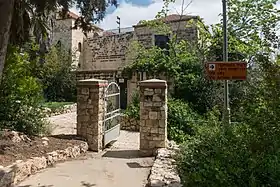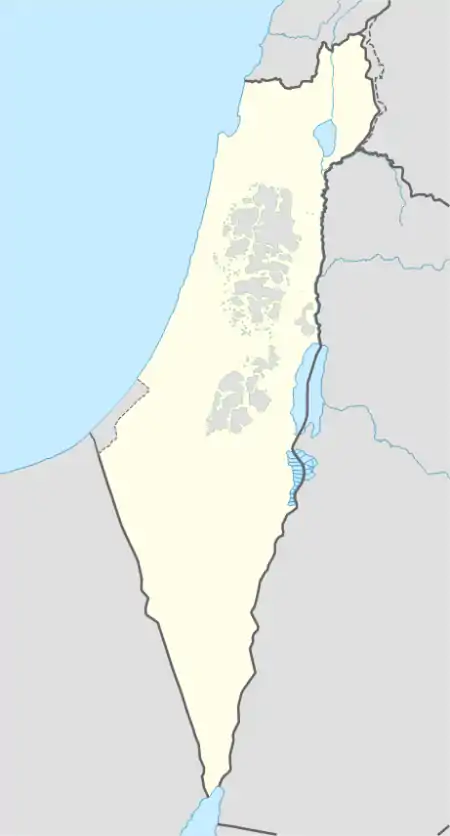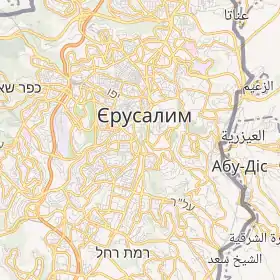Мішкенот Ша'ананім
Мішкенот Ша'ананім (івр. משכנות שאננים, букв. «спокійні місця») — перший єврейський квартал, за межами стін Старого міста в Єрусалимі, на пагорбі прямо навпроти гори Сіон. Збудований у 1859—1860 роках[1], є одним із перших комплексів, побудованих за межами Старого міста, серед інших — Керем Аврагам, сиротинець Шнеллера, протестанська школа єпископа Самуеля Ґобата та Російське подвір'я[2].
|
Мішкенот Ша'ананім
Координати 31°46′17″ пн. ш. 35°13′27″ сх. д.
|
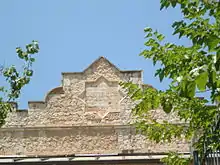
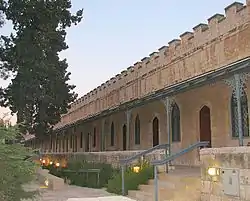
Історія
Османський період
Мішкенот Ша'анім побудував британський єврейський банкір і філантроп, сер Мозес Монтефіоре, в 1860 році. Для цього він придбав землю у губернатора Єрусалиму Ахмада Аґи Дуздара[3]. Квартал звели як соціальне житло за кошти американського єврейського бізнесмена з Нового Орлеана Джуда Туро[4]. Квартал був за межами стін міста, а отже, не був захищеним від бедуїнських набігів, мародества та загалом бандитизму, що саме розквітло у регіоні в той час, євреї не хотіли переїжджати туди, навіть незважаючи на те, що житло було розкішним у порівнянні з занедбаними й перенаселеними будинками у Єврейському кварталі Старого міста[1]. Щоб мотивувати людей, їм навіть платили за проживання у кварталі, а навколо комплексу спорудили кам'яну стіну з важкими дверима, які на ніч зачинялися[5]. Назва кварталу була взята з Книги Ісаї: «І осяде наро́д мій у мешка́нні спокі́йнім, і в безпечних місця́х, і в спокійних місцях відпочи́нку» (Іс. 32:18)[4]. Пізніше квартал став частиною району Ємін Моше, заснованого у 1892—1894 роках.
Йорданський період
Після арабо-ізраїльської війни, коли Старе місто захопив Арабський легіон, Мішкенот Ша'ананім межував з нічийною землею поблизу лінії перемир'я з Йорданським королівством, і багато жителів покинули район після снайперських атак йорданських арабських легіонерів[6].
Відновлення після 1967 року
Нічийну землю, що межує з Мішкенот Ша'ананім, Ізраїль захопив під час війни 1967 року разом з рештою Східного та Старого Єрусалиму.[7].
1973 року Мішкенот Ша'ананім перетворили в елітний готельний комплекс для всесвітньовідомих авторів, художників і музикантів, які відвідують Ізраїль[4]. Окрім готелю, там є конференц-центр і будинок Єрусалимського музичного центру[1]. Музичний центр відкрив Пабло Касальс незадовго до його смерті[4].
1997 тут відкрили Єрусалимський центр етики. Їцхак Замір очолював його правління після виходу на пенсію з посади судді Верховного суду Ізраїлю в 2001 році[8][9].
 Квартал Монтефіоре — Мішкенот Ша'ананім (1948)
Квартал Монтефіоре — Мішкенот Ша'ананім (1948) Пам'ятник «Полум'я Еціоні»
Пам'ятник «Полум'я Еціоні»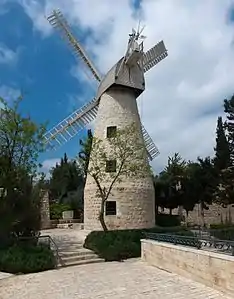 Вітряк Монтефіоре
Вітряк Монтефіоре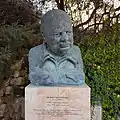 Статуя Вінстона Черчілля Оскара Немона (2002)
Статуя Вінстона Черчілля Оскара Немона (2002) «Єрусалим як центр світу» Девіда Броєр-Вайля (за картою світу Генріха Бюнтінга), парк Тедді Коллека (2016)
«Єрусалим як центр світу» Девіда Броєр-Вайля (за картою світу Генріха Бюнтінга), парк Тедді Коллека (2016)
Див. також
- Меа Шеарім
- Єрусалимський міжнародний фестиваль письменників
- Розширення Єрусалиму в XIX столітті
Посилання
- Mishkenot Sha'ananim: From Alms House to Cultural Centre - Jerusalem's First Building Outside the Old City's Wall. ARIEL: The Israel Review of Arts and Letters. Jerusalem: Ministry of Foreign Affairs (Israel). 1996. Процитовано 23 серпня 2021.
- Kark, Ruth; Oren-Nordheim, Michal (2001). Jerusalem and Its Environs: Quarters, Neighborhoods, Villages, 1800-1948. Israel studies in historical geography. Wayne State University Press. с. 74; table on p.82–86. ISBN 9780814329092. Процитовано 23 серпня 2021. «The beginning of construction outside the Jerusalem Old City in the mid-19th century was linked to the changing relations between the Ottoman government and the European powers. After the Crimean War, various rights and privileges were extended to non-Muslims who now enjoyed greater tolerance and more security of life and property. All of this directly influenced the expansion of Jerusalem beyond the city walls. From the mid-1850s to the early 1860s, several new buildings rose outside the walls, among them the mission house of the English consul, James Finn, in what came to be known as Abraham's Vineyard (Kerem Avraham), the Protestant school built by Bishop Samuel Gobat on Mount Zion; the Russian Compound; the Mishkenot Sha’ananim houses: and the Schneller Orphanage complex. These complexes were all built by foreigners, with funds from abroad, as semi-autonomous compounds encompassed by walls and with gates that were closed at night. Their appearance was European, and they stood out against the Middle-Eastern-style buildings of Palestine.»
- Diaries of Sir Moses and Lady Montefiore : comprising their life and work as recorded in their diaries from 1812 to 1883, Volume 2, pages 51-52: "Ahhmed Agha Dizdar, who had been Governor of Jerusalem during the reign of Mohhammad Ali, and who since the year 1839 had stood in friendly relations with Sir Moses, was the owner of the land in question. When Sir Moses broached the subject of the purchase to him, his answer was: «You are my friend, my brother, the apple of my eye, take possession of it at once. This land I hold as an heirloom from my ancestors. I would not sell it to any person for thousands of pounds, but to you I give it without any money: it is yours, take possession of it.» « I myself, my wife, and children, we all are yours.» And this was his reply to Sir Moses day after day, whenever he was asked the price for which he would sell the said property. Ultimately, after a whole day's most friendly argument, which almost exhausted all my stock of Arabic phraseology (having acted as interpreter between him and Sir Moses), he said to me: «You are my friend, my brother; by my beard, my head, I declare this is the case. Tell Sir Moses to give me a souvenir of one thousand pounds sterling, and we will go at once to the Ckadee.»
- Dudman, Helga (1982). Street People. The Jerusalem Post/Carta (1st ed.), Hippocrene Books (2nd ed.). с. 21–22. ISBN 978-965-220-039-6. Not available on Google Books as of August 2021.
- Yemin Moshe and Mishkenot Sha'ananim. Pinhas Baraq for The Jewish Agency for Israel's Department for Jewish Zionist Education. Архів оригіналу за 22 грудня 2009. Процитовано 3 жовтня 2013. More information about Yemin Moshe
- Klein, Menachem (2014). Lives in Common: Arabs and Jews in Jerusalem, Jaffa and Hebron. Oxford University Press. с. 128. ISBN 9780190257460. Процитовано 23 серпня 2021.
- Israel and the Palestinians: Key Maps. BBC News. Процитовано 23 серпня 2021.
- Konrad Adenauer Conference Center of Mishkenot Sha'ananim. Архів оригіналу за 21 жовтня 2009.
- Itzhak Zamir at the National Library of Israel homepage. Posted before 2019, accessed 23 Aug. 2021.
